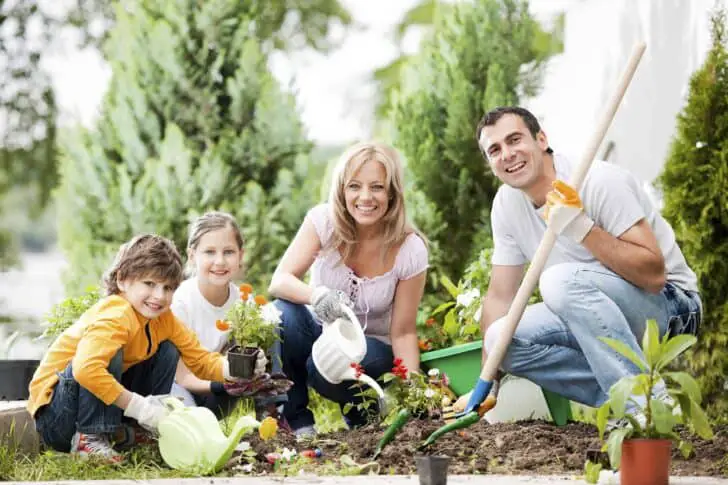
Looking for a healthy, fun activity to try out with your kids? Well, you should consider gardening.
Gardening is a wonderful activity that’d yield delightful rewards for your time and effort. Nothing can be more satisfying than seeing your effort and hard work pan out as planned.
If you are wondering why we are recommending this for your kids and what they stand to gain, check this out…
Table of Contents
It Brings You Closer to Your Kids.
Gardening gives you the opportunity to strengthen the bond between you and your kids. Working with your kids towards a blooming garden brings you closer on every level.
Have zero experience in gardening or still learning the how? This is even more reason to get your kids involved early on as learning how to do things with your kids is a great bond builder. Learning together gives you the opportunity to show your kids how to make progress, work as a team, and follow things through to success.
Guess what? Gardening is an activity that requires a lot of time, especially at the beginning, so you get to spend quality time with your kids which without doubt strengthens your bond.
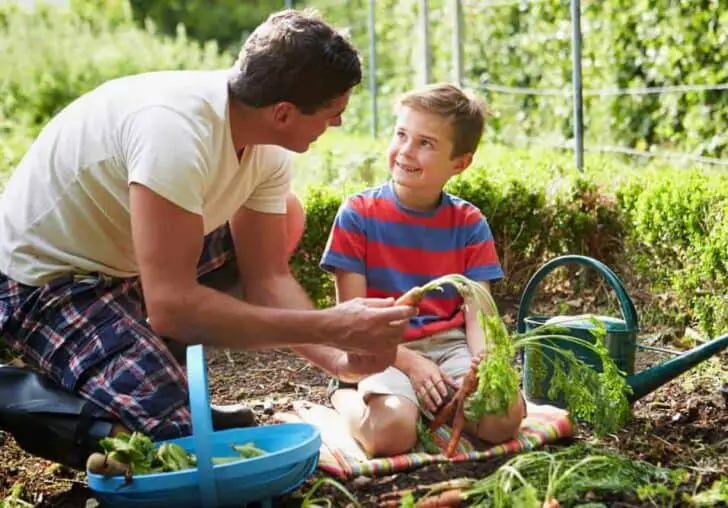
Even if you are an experienced gardener, this is a great opportunity to mentor your kids and pass on your knowledge to them.
Keep in mind that the family that spend quality time together, stay together.
It Broadens and Improves Your Kids’ Imagination and Creativity.
Kids love to play and explore. They love adventure and can get really creative when it comes to telling and acting out stories with their toys.
Gardening gives enough room for kids to express and grow their creativity as they also get to engage their imagination. This makes them see gardening as a means to an exciting, tasty end. They get to have all their senses engaged from feeling soil textures, smelling the flowers, seeing plants bloom, to tasting the edible ones.
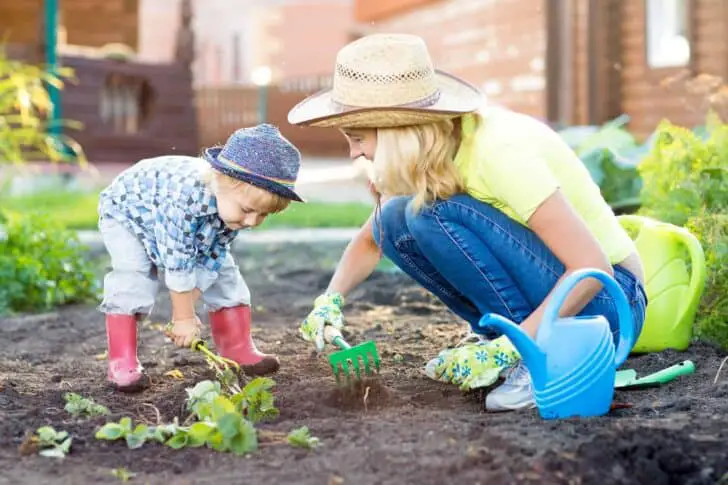
They get to be plant “care-takers/protectors” when they see and learn about the little insects/animals that live in the soil and garden. They learn about the useful little animals that encourage plant growth as well as harmful ones that inhibit growth and how to protect plants from them. They can liken the experience to fighting off villains from harming their loved ones. This would make them feel like super heroes when their garden remains healthy and stays protected all season.
When kids are allowed to create, it provides more hold for their imagination and creativity. Through gardening, kids get to see their creativity come alive.
Kids love to believe they are part of something big and gardening would afford them the opportunity to be “growers”. When they realise that they can provide food for themselves and the family through gardening, they get excited.
They begin to imagine creating a huge forest of edible plants for everyone and they won’t be disappointed as they would be able to see their hard work paying off.
It Develops Your Kids Intellectual Capacity.
According to a Backyard boss team’s research, it has been proven that gardening helps kids build their intellectual capacity, problem-solving skills, ability to analyze situations and many more.
There are endless learning opportunities available for your kids while gardening: This ranges from teaching them how much space each plant needs to flourish to how to plan their finances and how to budget when buying gardening supplies.
They also have the opportunity to sharpen their literacy skills from reading the instructions on the packages of seeds/plants or learning how to pronounce their names.
You could also create a map of the garden with your kids, labeling the plants in it. This is also a great way of teaching your kids how to read and write as it’d come in handy when the seeds start germinating and you need to differentiate the weeds from the seeds.
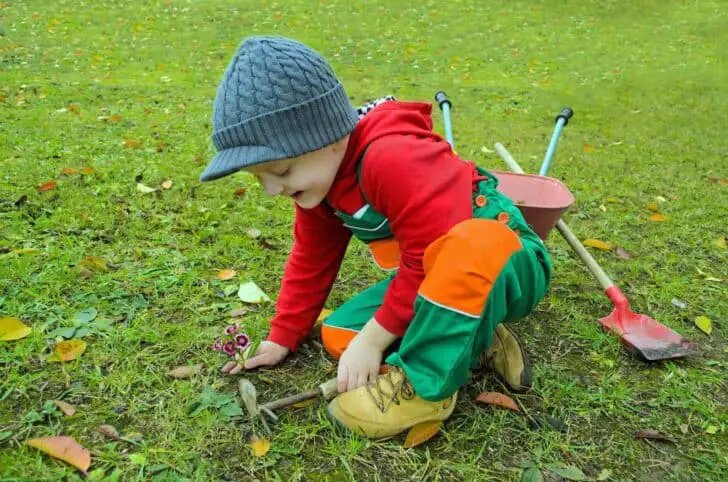
When they learn how to make use of a rake or trowel to pick up seeds and plant them, the whole-hand grasp they employ in handling the tools helps them in developing fine motor skills that come in handy when writing.
Asking questions like, “John, what do you think comes next after putting the seeds in the soil?” and other related open ended questions helps your kids in their thinking process from preparing the soil for planting, planting seeds, watering them and getting rid of weeds.
If you plant more than one type of seed, ensure they can differentiate between them. All these contributes to their cognitive development.
Have a kid with special needs? No problem at all. In fact, a research done by Perkins-will unanimously concluded that gardens can be therapeutic for kids with special needs even if they are autistic.
Apart from the cognitive and intellectual development that can be achieved from gardening, kids with special needs are able to experience what it feels like to visibly achieve something. This serves as an effective form of therapy for them.
If you have a kid with special needs and they can go outside, don’t hold back from gardening with them!
It Teaches Kids to Be Responsible and Patient.
As parents, we want to watch our kids grow into independent, responsible adults. We want them to be able to survive and succeed in the outside world.
We don’t want them missing their appointments, failing at their relationships with people or even losing their jobs because they don’t take responsibility for their actions in the future. We want them to understand the importance of being responsible and always have that responsibility mindset.
Now you may ask, “How does gardening help out with all of these?”
The answer is simple. Teaching your kids how to care for the garden also means teaching them how to be responsible for the garden else it won’t thrive.
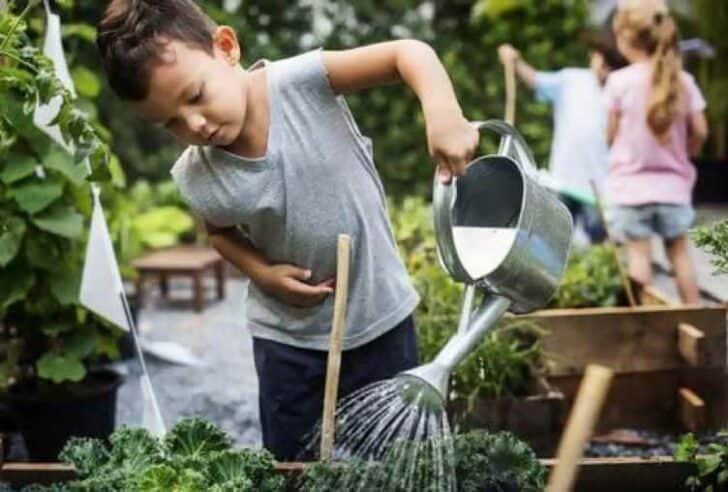
The special role placed on your kids to ensure that the plants are watered daily, weeds are regularly removed and harvesting is done on time is already a great start to teaching your kids on taking responsibility for their actions else they won’t have delightful rewards in the end. This is a key learning point for kids that they’d get out what efforts they put in.
They also learn to be patient as they’ve to wait for the plants to grow. Being responsible and patient goes hand in hand. So, as they learn to be responsible by carrying out their duties, they also learn to remain engaged and not give up till they see results.
Imagine their joy when they see the first sprout!
So, now that we know all our kids stand to gain from getting involved in gardening, here’s how to get started…
Come Up with a Budget.
It’s important to have a budget when you’re ready to go shopping for garden supplies with your kids. This stands to be a great learning opportunity for your kids as you can teach them how to stick to a budget and not exceed it.

A great opportunity for your kids to learn how to be money smart!
Take your time in planning the shopping list with your kids and explain why every item on the list is necessary.
After listing the items out, identify the ones that are available in the house and then use this in explaining to your kids why there isn’t a need to buy brand new items to replace existing ones which teaches them to be resourceful.
Asides kids’ gardening tools, you can save more by going for cheaper options like:
- Investing in a pack of seeds to give you access to more that can be gotten from the plants when they grow. This would reduce or totally remove the budget for seeds once your garden is well established.
- Soil tests show that there are certain chemicals the soil needs to be healthy and balanced. You can have this taken care of naturally with composting.
- You could substitute expensive planting pots/containers with biodegradable eggshells or newspapers and once the seeds takes root, they can be easily transferred into the ground.
- If you are aiming for different types of plants, instead of buying expensive labels to differentiate them, you can simply create yours by gluing the seed packet to sticks.
Decide on the Type of Garden You Want.
If you have a garden established already, it’s ok to work with that. If you don’t have one already, you can make your choice from the garden styles below which are both great for kids and if you’re a beginner yourself:
Raised Garden Style.
This is also the same as a container garden style as they are both contained above the ground.
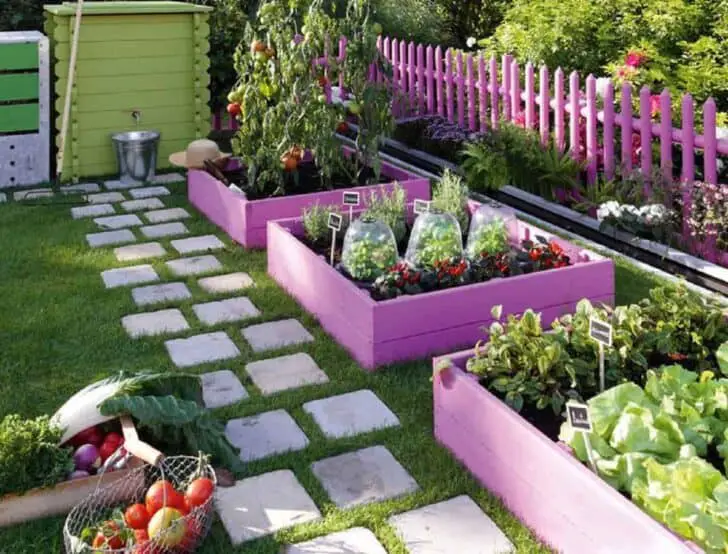
Here are some pros of investing in a raised garden style:
- You put less strain on your body as you tend to your garden since they are higher above the ground.
- They warm up the soil faster in spring and this gives room for earlier planting.
- It gives you the opportunity to match soil to corresponding plants that would thrive.
- They work great for people with special needs.
The Con sides
- The materials needed in setting up this garden style can be quite costly.
- Constructing the borders can be time-consuming, taking up useful gardening time.
- The soil tends to dry out faster in summer and would require more watering.
- It puts a lot of restrictions on soil manipulations and a lot of work would have to be done by hand.
In-Ground Garden Style.
For this garden style, planting is done directly in the ground. Unlike the raised garden style, there is no construction work involved.
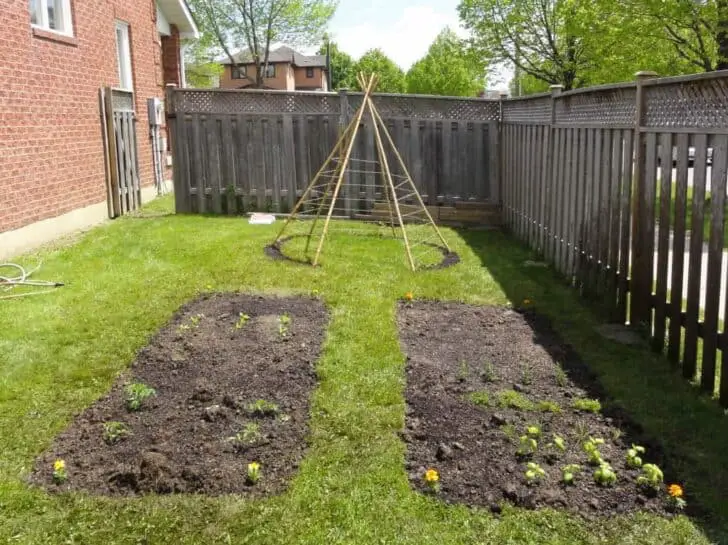
Here are some pros of using the in-ground garden style:
- It’s cheaper as you don’t need to construct anything before you start planting.
- They are best for dry seasons as they can hold water longer.
- The only limits you have to your space is that of your property.
The Con sides
- If you live in a region with high precipitation, this could be harmful to your garden.
- Puts more strain on your body while tending to your garden.
- Weeds would thrive more, giving you extra work.
It would be really enlightening for you to discuss pros and cons of these styles with your kids before reaching a final decision. Involving your kids will teach your kids how to make effective decisions by weighing the possibilities.
Get Tools Suited for Kids’ Use.
Gardening with your kids would require some investment in tools that are well-suited for them. Fortunately, the gardening industry has done really well in adjusting and making strong tools to fit smaller hands hence, making available varieties of basic, fun tools that your kids can make use of in the garden.
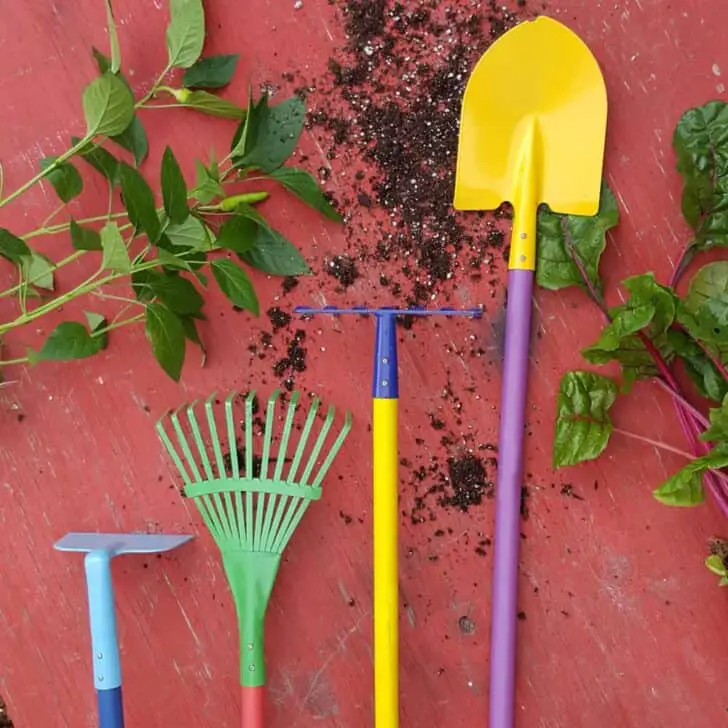
While planning your supply list, here are some basic tools you should look out for:
- Gloves.
- Trowel.
- Shovel.
- Hand and full-sized rake.
- Shears and loppers.
- A wheelbarrow.
- A good hose.
Choose What to Plant
Choosing what seeds to plant can come off as easy as going with your cravings although you are likely to be dealing with vegetables or fruits on your garden. Considering that kids are not usually great fans of healthy food, we would need to come up with exciting ways for them to get interested.
A creative way to get your kids interested and involved in the gardening process is to come up with a theme for the garden either from something your kids love eating, like pizza, or salads. After coming up with the theme, discuss what makes up the snack they love and plan a garden around one or more of the items.
For example, if your kids love pizza, you could start by telling them about the veggies –peppers, onions, tomatoes etc- that go on it and inform them of a decision to plant one or more of this. This would go a long way in keeping them interested as they’d believe they’re growing something useful that is a crucial part of what they love eating.
Also, look into fast growing seeds you can invest in if you know your kids lose interest in activities easily.
Again, it’s important to understand soil types as they’re an essential part of plant growth. A healthy soil is important for a healthy garden and wouldn’t require as much fertilizer to support growth.
“Is it possible to know if my garden soil is healthy?” You ask.
YES.
The best way to know the state of your garden soil is to test it.
This would turn out to be an amazing learning opportunity for you and your kids. Once you are done with the tests, you would know what your garden soil lacks and then replenish it accordingly.
There are about 17+ essential soil elements that are important for plants to grow well. However, three have been considered to be primary and secondary:
- Nitrogen.
- Phosphorous.
- Potassium.
The three secondary elements are:
- Calcium.
- Sulphur.
- Magnesium.
Getting a fertilizer that contains these elements would go a long way in nourishing your garden soil.
Asides fertilizer, you could make compost with your kids for the garden soil. This can be a great way for them to learn how things decompose too.
To learn how to compost, you could buy a book to study with your kids which makes for a stronger bond as you spend time studying or reading together.
Knowing your plants and soil types is quite important as it would help in determining the amount of water needed based on the plant type and the soil water retention level.
If you discover your soil isn’t holding much water, you would need to do a soil test and replenish the missing elements by making use of fertilizers or compost.
Sometimes, even healthy soil can seem not to be able to retain water. In such a case, there is need for the soil to be aerated which can be done by creating air packets in the soil that would help the soil in water retention.
Some plants require more sunlight and moisture than others. Most times, the amount needed would be stated on the seeds’ packages.
Watering your plants regularly makes for a healthy soil and saves you water in the end. Healthy soil doesn’t require so much moisture as it retains water efficiently.
Here’s a watering chart to give you an idea of how much water your plants need and when to water them.
Just like water, your plants need sunlight to survive. You can get a sunlight meter which would show you the amount of sunlight gotten over a day in any spot of the garden.
Always refer to the instructions on the body of the seeds’ packages to know the requirements and to follow through accordingly.
Harvest at the Right Time.
Harvesting is without a doubt the most fascinating part of gardening for kids as they finally get to see the results of their hard-work and patience.
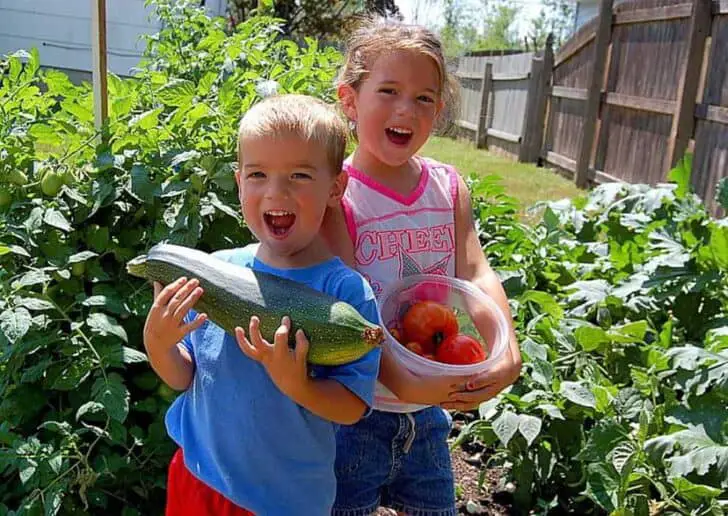
However, it’s important to harvest at the right time – not too early, not too late-. If your plants grow above the ground as in the case of tomatoes, it’s easier to know when they are ripe and ready to be harvested. They could appear fuller or even fall off the stems to the ground. If this isn’t the case, it’s not yet time.
For plants that grow in-ground, like carrots, knowing if they’re ready to be harvested can be judged from the appearance of their visible parts, like the leaves. If you find yourself pulling out produce from the ground, it simply means the produce is not yet matured.
You can also refer to the seed’s packets for final results.
It’d be a whole lot of fun and an exciting experience to go round the garden with your kids on a harvesting spree of your garden produce.
You can prolong the exciting experience by cooking the produce from your garden with your kids or just washing and eating your fresh produce with them.
They’re sure to want to relive the experience again.
Gardening is definitely one of the best activities to participate in with your kids. It gives you the opportunity to teach and see your kids learn how to take responsibility and not neglect them. It also helps them become better intellectually and draw them closer to you.
It’s definitely an amazing way to show your kids the exciting rewards for hard work and expose them to a healthy way of development.
Don’t wait any longer, get out there and give gardening a try with your kids and be thrilled by all you can gain with your kids from the time and effort you give.
Know someone who needs to see this too? Do well to SHARE!
